1.AQS是什么?
从字面上来看:抽象的队列同步器
关键词:队列 同步器
位置:package java.util.concurrent.locks;
AbstractQueuedSynchronizer
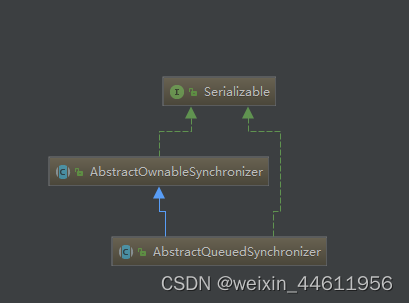
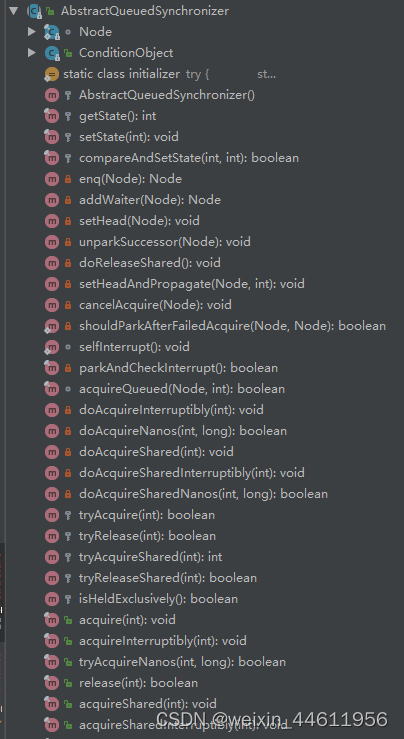
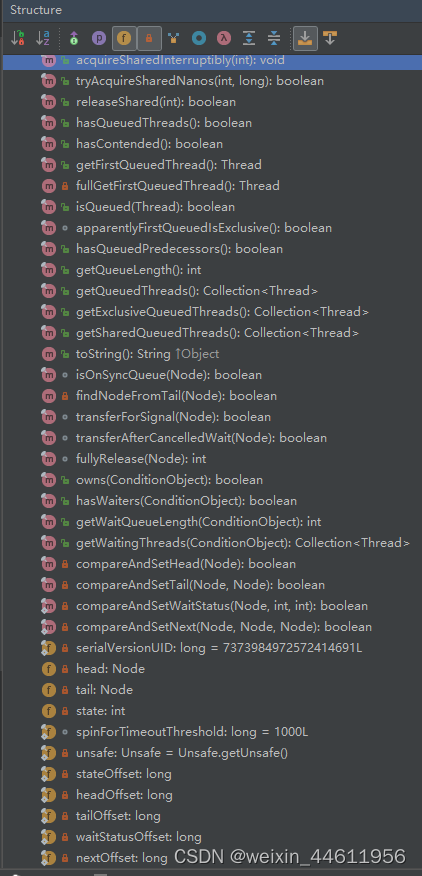
2.它能做什么,解决什么问题?
因为加锁就会有阻塞的时候,所以我们就需要一个队列能管理等待的线程。
如何去管理?AQS就是这个问题的落地实现。
3.简介图
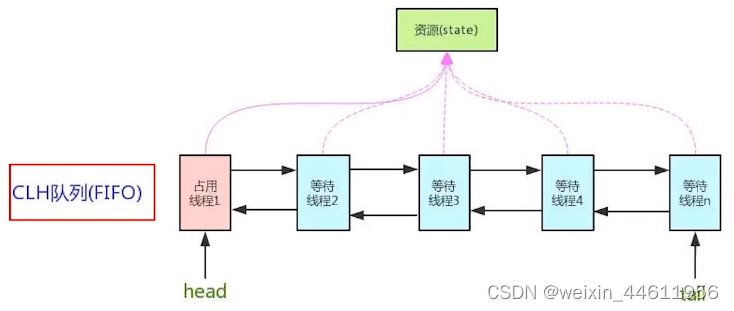
4.源码解析
- AQS功能简介
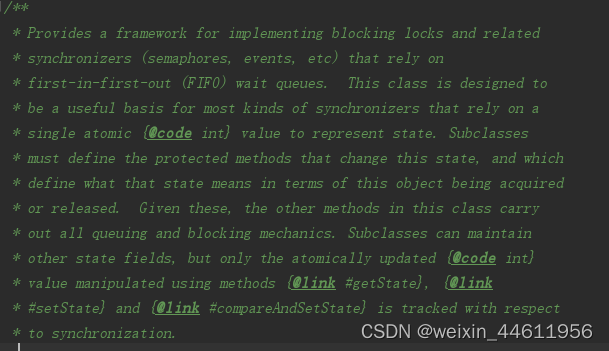
- AQS 重要属性
/**
* The synchronization state.
*/
private volatile int state;
/**
* Head of the wait queue, lazily initialized. Except for
* initialization, it is modified only via method setHead. Note:
* If head exists, its waitStatus is guaranteed not to be
* CANCELLED.
*/
private transient volatile Node head;//头节点
/**
* Tail of the wait queue, lazily initialized. Modified only via
* method enq to add new wait node.
*/
private transient volatile Node tail;//尾节点
AQS使用一个volatile的int类型的成员变量来表示同步状态,通过内置的FIFO(FIRST IN FIRST OUT)队列来完成资源获取的排队工作将每条要去抢占资源的线程封装成一个Node节点来实现锁的分配,通过CAS完成对State值的修改。
- . 引入银行排队办理业务案例,加深记忆和理解
state成员变量相当于银行办理业务的受理窗口状态:
0就是没人,自由状态可以办理;
大于等于1,有人占用窗口,需要排队等。
AQS的CLH队列
CLH队列(三个大牛的名字组成),为一个双向队列,可以类比于银行候客区的等待顾客。
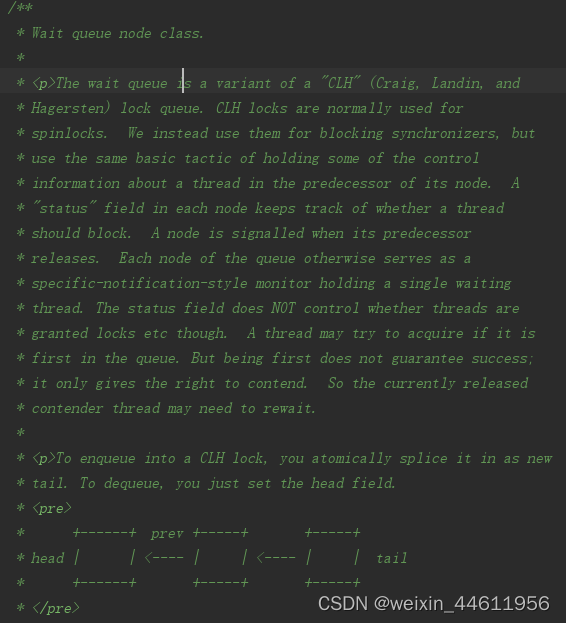
既然队列里面放的是一个个Node,那我们通过源码看下这个Node都有啥?怎么工作的?类比于排队等候的顾客。
static final class Node {
/** Marker to indicate a node is waiting in shared mode */
//表示线程以共享的模式等待锁
static final Node SHARED = new Node();
/** Marker to indicate a node is waiting in exclusive mode */
//表示线程正在以独占的方式等待锁
static final Node EXCLUSIVE = null;
/** waitStatus value to indicate thread has cancelled */
//线程被取消了
static final int CANCELLED = 1;
/** waitStatus value to indicate successor's thread needs unparking */
//后继线程需要唤醒
static final int SIGNAL = -1;
/** waitStatus value to indicate thread is waiting on condition */
//等待condition唤醒
static final int CONDITION = -2;
/**
* waitStatus value to indicate the next acquireShared should
* unconditionally propagate
*/
//共享式同步状态获取将会无条件地传播下去
static final int PROPAGATE = -3;
/**
* Status field, taking on only the values:
* SIGNAL: The successor of this node is (or will soon be)
* blocked (via park), so the current node must
* unpark its successor when it releases or
* cancels. To avoid races, acquire methods must
* first indicate they need a signal,
* then retry the atomic acquire, and then,
* on failure, block.
* CANCELLED: This node is cancelled due to timeout or interrupt.
* Nodes never leave this state. In particular,
* a thread with cancelled node never again blocks.
* CONDITION: This node is currently on a condition queue.
* It will not be used as a sync queue node
* until transferred, at which time the status
* will be set to 0. (Use of this value here has
* nothing to do with the other uses of the
* field, but simplifies mechanics.)
* PROPAGATE: A releaseShared should be propagated to other
* nodes. This is set (for head node only) in
* doReleaseShared to ensure propagation
* continues, even if other operations have
* since intervened.
* 0: None of the above
*
* The values are arranged numerically to simplify use.
* Non-negative values mean that a node doesn't need to
* signal. So, most code doesn't need to check for particular
* values, just for sign.
*
* The field is initialized to 0 for normal sync nodes, and
* CONDITION for condition nodes. It is modified using CAS
* (or when possible, unconditional volatile writes).
*/
//当前节点在队列中的状态(重点)
//说人话:
//等候区其它顾客(其它线程)的等待状态
//队列中每个排队的个体就是一个Node
//初始为0,状态上面的几种
volatile int waitStatus;
/**
* Link to predecessor node that current node/thread relies on
* for checking waitStatus. Assigned during enqueuing, and nulled
* out (for sake of GC) only upon dequeuing. Also, upon
* cancellation of a predecessor, we short-circuit while
* finding a non-cancelled one, which will always exist
* because the head node is never cancelled: A node becomes
* head only as a result of successful acquire. A
* cancelled thread never succeeds in acquiring, and a thread only
* cancels itself, not any other node.
*/
//前驱节点(重点)
volatile Node prev;
/**
* Link to the successor node that the current node/thread
* unparks upon release. Assigned during enqueuing, adjusted
* when bypassing cancelled predecessors, and nulled out (for
* sake of GC) when dequeued. The enq operation does not
* assign next field of a predecessor until after attachment,
* so seeing a null next field does not necessarily mean that
* node is at end of queue. However, if a next field appears
* to be null, we can scan prev's from the tail to
* double-check. The next field of cancelled nodes is set to
* point to the node itself instead of null, to make life
* easier for isOnSyncQueue.
*/
//后继节点(重点)
volatile Node next;
/**
* The thread that enqueued this node. Initialized on
* construction and nulled out after use.
*/
//表示处于该节点的线程
volatile Thread thread;
/**
* Link to next node waiting on condition, or the special
* value SHARED. Because condition queues are accessed only
* when holding in exclusive mode, we just need a simple
* linked queue to hold nodes while they are waiting on
* conditions. They are then transferred to the queue to
* re-acquire. And because conditions can only be exclusive,
* we save a field by using special value to indicate shared
* mode.
*/
//指向下一个处于CONDITION状态的节点
Node nextWaiter;
/**
* Returns true if node is waiting in shared mode.
*/
//返回前驱节点,没有的话抛出npe
final boolean isShared() {
return nextWaiter == SHARED;
}
/**
* Returns previous node, or throws NullPointerException if null.
* Use when predecessor cannot be null. The null check could
* be elided, but is present to help the VM.
*
* @return the predecessor of this node
*/
final Node predecessor() throws NullPointerException {
Node p = prev;
if (p == null)
throw new NullPointerException();
else
return p;
}
Node() { // Used to establish initial head or SHARED marker
}
Node(Thread thread, Node mode) { // Used by addWaiter
this.nextWaiter = mode;
this.thread = thread;
}
Node(Thread thread, int waitStatus) { // Used by Condition
this.waitStatus = waitStatus;
this.thread = thread;
}
}
AQS同步队列的基本结构

小总结:
1.有阻塞就需要排队,实现排队必然需要队列
2.state变量+CLH变种的双端队列
4.1 通过可重入锁ReentrantLock debug AQS框架体系源码
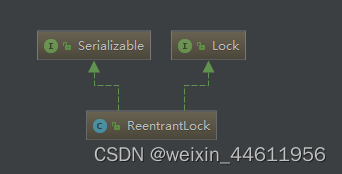
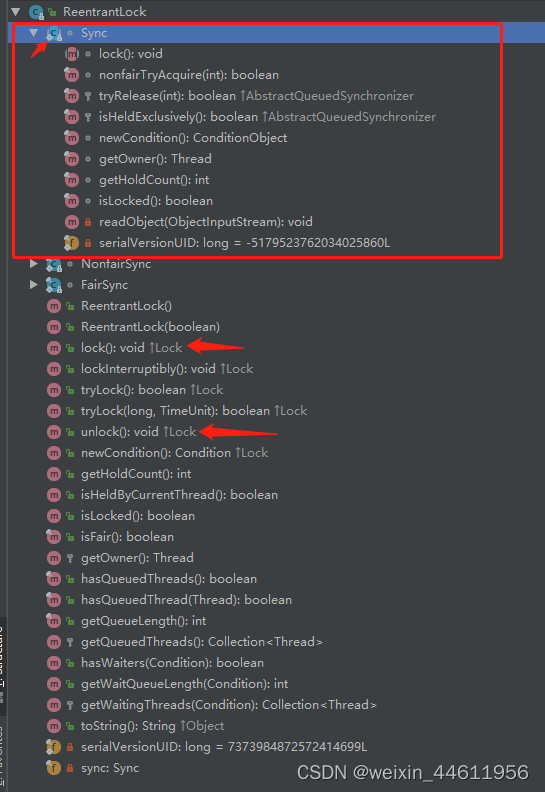

Lock接口的实现类,基本都是通过聚合了一个队列同步器的子类完成线程访问控制的。
public class ReentrantLock implements Lock, java.io.Serializable {
private static final long serialVersionUID = 7373984872572414699L;
private final Sync sync;
abstract static class Sync extends AbstractQueuedSynchronizer
static final class NonfairSync extends Sync
static final class FairSync extends Sync
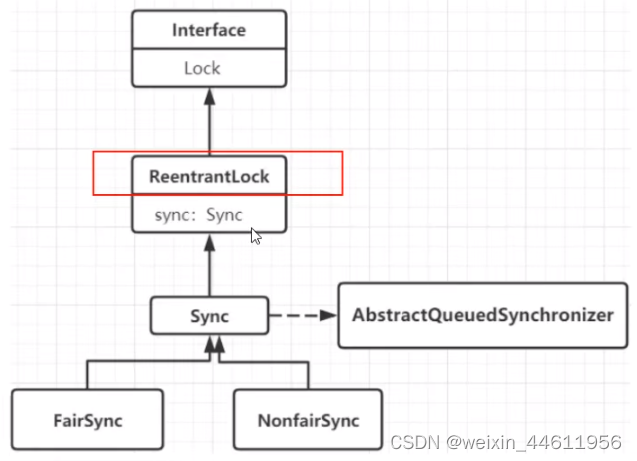
了解完设计结构后 开始debug,直捣黄龙,一探究竟
从最简单的lock方法开始看看公平和非公平,先浏览下AbstractQueuedSynchronizer,FairSync,NonfairSync类的源码。

* A reentrant mutual exclusion {@link Lock} with the same basic
public class ReentrantLock implements Lock, java.io.Serializable {
private static final long serialVersionUID = 7373984872572414699L;
/** Synchronizer providing all implementation mechanics */
private final Sync sync;
* Base of synchronization control for this lock. Subclassed
abstract static class Sync extends AbstractQueuedSynchronizer {
* Sync object for non-fair locks
static final class NonfairSync extends Sync {
* Sync object for fair locks
static final class FairSync extends Sync {
* Creates an instance of {@code ReentrantLock}.
public ReentrantLock() {
sync = new NonfairSync();
}
* Creates an instance of {@code ReentrantLock} with the
public ReentrantLock(boolean fair) {
sync = fair ? new FairSync() : new NonfairSync();
}
* Acquires the lock.
public void lock() {
sync.lock();//<------------------------注意,我们从这里入手
}
* Attempts to release this lock.
public void unlock() {
sync.release(1);
}
...
}
public abstract class AbstractQueuedSynchronizer
extends AbstractOwnableSynchronizer
implements java.io.Serializable {
...
* Acquires in exclusive mode, ignoring interrupts. Implemented
public final void acquire(int arg) {//公平锁或非公平锁都会调用这方法
if (!tryAcquire(arg) &&//0.
acquireQueued(addWaiter(Node.EXCLUSIVE), arg))//1. 2.
selfInterrupt();//3.
}
//0.
* Attempts to acquire in exclusive mode. This method should query
protected boolean tryAcquire(int arg) {//取决于公平锁或非公平锁的实现
throw new UnsupportedOperationException();
}
//1.
* Acquires in exclusive uninterruptible mode for thread already in
final boolean acquireQueued(final Node node, int arg) {
boolean failed = true;
try {
boolean interrupted = false;
for (;;) {
final Node p = node.predecessor();
if (p == head && tryAcquire(arg)) {
setHead(node);
p.next = null; // help GC
failed = false;
return interrupted;
}
if (shouldParkAfterFailedAcquire(p, node) &&
parkAndCheckInterrupt())
interrupted = true;
}
} finally {
if (failed)
cancelAcquire(node);
}
}
//2.
* Creates and enqueues node for current thread and given mode.
private Node addWaiter(Node mode) {
Node node = new Node(Thread.currentThread(), mode);
// Try the fast path of enq; backup to full enq on failure
Node pred = tail;
if (pred != null) {
node.prev = pred;
if (compareAndSetTail(pred, node)) {
pred.next = node;
return node;
}
}
enq(node);
return node;
}
//3.
static void selfInterrupt() {
Thread.currentThread().interrupt();
}
//这个方法将会被公平锁的tryAcquire()调用
* Queries whether any threads have been waiting to acquire longer
public final boolean hasQueuedPredecessors() {
// The correctness of this depends on head being initialized
// before tail and on head.next being accurate if the current
// thread is first in queue.
Node t = tail; // Read fields in reverse initialization order
Node h = head;
Node s;
return h != t &&
((s = h.next) == null || s.thread != Thread.currentThread());
}
...
}
public class ReentrantLock implements Lock, java.io.Serializable {
...
//非公平锁与公平锁的公共父类
* Base of synchronization control for this lock. Subclassed
abstract static class Sync extends AbstractQueuedSynchronizer {
...
final boolean nonfairTryAcquire(int acquires) {
final Thread current = Thread.currentThread();
int c = getState();
if (c == 0) {
if (compareAndSetState(0, acquires)) {
setExclusiveOwnerThread(current);
return true;
}
}
else if (current == getExclusiveOwnerThread()) {
int nextc = c + acquires;
if (nextc < 0) // overflow
throw new Error("Maximum lock count exceeded");
setState(nextc);
return true;
}
return false;
}
...
}
//非公平锁
static final class NonfairSync extends Sync {
private static final long serialVersionUID = 7316153563782823691L;
/**
* Performs lock. Try immediate barge, backing up to normal
* acquire on failure.
*/
final void lock() {//<---ReentrantLock初始化为非公平锁时,ReentrantLock.lock()将会调用这
if (compareAndSetState(0, 1))
setExclusiveOwnerThread(Thread.currentThread());
else
acquire(1);//调用父类AbstractQueuedSynchronizer的acquire()
}
//acquire()将会间接调用该方法
protected final boolean tryAcquire(int acquires) {
return nonfairTryAcquire(acquires);//调用父类Sync的nonfairTryAcquire()
}
}
* Sync object for fair locks
static final class FairSync extends Sync {
private static final long serialVersionUID = -3000897897090466540L;
final void lock() {//<---ReentrantLock初始化为非公平锁时,ReentrantLock.lock()将会调用这
acquire(1);调用父类AbstractQueuedSynchronizer的acquire()
}
//acquire()将会间接调用该方法
* Fair version of tryAcquire. Don't grant access unless
protected final boolean tryAcquire(int acquires) {
final Thread current = Thread.currentThread();
int c = getState();
if (c == 0) {
if (!hasQueuedPredecessors() &&//<---公平锁与非公平锁的唯一区别,公平锁调用hasQueuedPredecessors(),而非公平锁没有调用
//hasQueuedPredecessors()在父类AbstractQueuedSynchronizer定义
compareAndSetState(0, acquires)) {
setExclusiveOwnerThread(current);
return true;
}
}
else if (current == getExclusiveOwnerThread()) {
int nextc = c + acquires;
if (nextc < 0)
throw new Error("Maximum lock count exceeded");
setState(nextc);
return true;
}
return false;
}
}
...
}
可以明显看出公平锁与非公平锁的lock()方法唯一的区别就在于公平锁在获取同步状态时多了一个限制条件:hasQueuedPredecessors()
hasQueuedPredecessors是公平锁加锁时判断等待队列中是否存在有效节点的方法
对比公平锁和非公平锁的tyAcquire()方法的实现代码,其实差别就在于非公平锁获取锁时比公平锁中少了一个判断!hasQueuedPredecessors()
hasQueuedPredecessors()中判断了是否需要排队,导致公平锁和非公平锁的差异如下:
公平锁:公平锁讲究先来先到,线程在获取锁时,如果这个锁的等待队列中已经有线程在等待,那么当前线程就会进入等待队列中;
非公平锁:不管是否有等待队列,如果可以获取锁,则立刻占有锁对象。也就是说队列的第一个排队线程在unpark(),之后还是需要竞争锁(存在线程竞争的情况下)
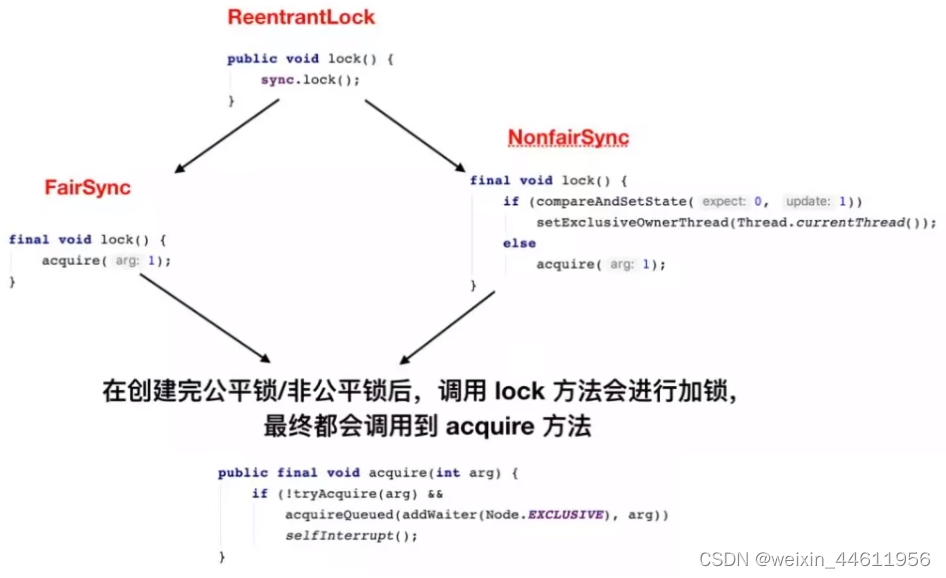
4.2 debug非公平锁的lock()
ReentrantLock的示例程序
带入一个银行办理业务的案例来模拟我们的AQS 如何进行线程的管理和通知唤醒机制,3个线程模拟3个来银行网点,受理窗口办理业务的顾客。
import java.util.concurrent.TimeUnit;
import java.util.concurrent.locks.ReentrantLock;
public class AQSDemo {
public static void main(String[] args) {
ReentrantLock lock = new ReentrantLock();
//带入一个银行办理业务的案例来模拟我们的AQs 如何进行线程的管理和通知唤醒机制
//3个线程模拟3个来银行网点,受理窗口办理业务的顾客
//A顾客就是第一个顾客,此时受理窗口没有任何人,A可以直接去办理
new Thread(()->{
lock.lock();
try {
System.out.println(Thread.currentThread().getName() + " come in.");
try {
TimeUnit.SECONDS.sleep(5);//模拟办理业务时间
} catch (InterruptedException e) {
e.printStackTrace();
}
} finally {
lock.unlock();
}
}, "Thread A").start();
//第2个顾客,第2个线程---->,由于受理业务的窗口只有一个(只能一个线程持有锁),此代B只能等待,
//进入候客区
new Thread(()->{
lock.lock();
try {
System.out.println(Thread.currentThread().getName() + " come in.");
} finally {
lock.unlock();
}
}, "Thread B").start();
//第3个顾客,第3个线程---->,由于受理业务的窗口只有一个(只能一个线程持有锁),此代C只能等待,
//进入候客区
new Thread(()->{
lock.lock();
try {
System.out.println(Thread.currentThread().getName() + " come in.");
} finally {
lock.unlock();
}
}, "Thread C").start();
}
}
程序初始状态方便理解图
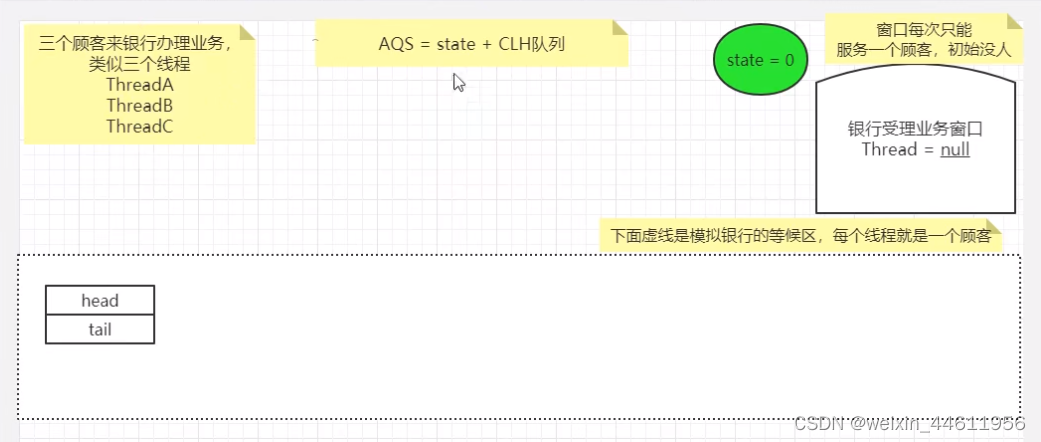
启动程序,首先是运行线程A,ReentrantLock默认是选用非公平锁。
public class ReentrantLock implements Lock, java.io.Serializable {
...
* Acquires the lock.
public void lock() {
sync.lock();//<------------------------注意,我们从这里入手,一开始将线程A的
}
abstract static class Sync extends AbstractQueuedSynchronizer {
...
//被NonfairSync的tryAcquire()调用
final boolean nonfairTryAcquire(int acquires) {
final Thread current = Thread.currentThread();
int c = getState();
if (c == 0) {
if (compareAndSetState(0, acquires)) {
setExclusiveOwnerThread(current);
return true;
}
}
else if (current == getExclusiveOwnerThread()) {
int nextc = c + acquires;
if (nextc < 0) // overflow
throw new Error("Maximum lock count exceeded");
setState(nextc);
return true;
}
return false;
}
...
}
//非公平锁
static final class NonfairSync extends Sync {
private static final long serialVersionUID = 7316153563782823691L;
/**
* Performs lock. Try immediate barge, backing up to normal
* acquire on failure.
*/
final void lock() {//<----线程A的lock.lock()调用该方法
if (compareAndSetState(0, 1))//AbstractQueuedSynchronizer的方法,刚开始这方法返回true
setExclusiveOwnerThread(Thread.currentThread());//设置独占的所有者线程,显然一开始是线程A
else
acquire(1);//稍后紧接着的线程B将会调用该方法。
}
//acquire()将会间接调用该方法
protected final boolean tryAcquire(int acquires) {
return nonfairTryAcquire(acquires);//调用父类Sync的nonfairTryAcquire()
}
}
...
}
public abstract class AbstractQueuedSynchronizer
extends AbstractOwnableSynchronizer
implements java.io.Serializable {
/**
* The synchronization state.
*/
private volatile int state;
//线程A将state设为1,下图红色椭圆区
/*Atomically sets synchronization state to the given updated value
if the current state value equals the expected value.
This operation has memory semantics of a volatile read and write.*/
protected final boolean compareAndSetState(int expect, int update) {
// See below for intrinsics setup to support this
return unsafe.compareAndSwapInt(this, stateOffset, expect, update);
}
}
线程A开始办业务了。
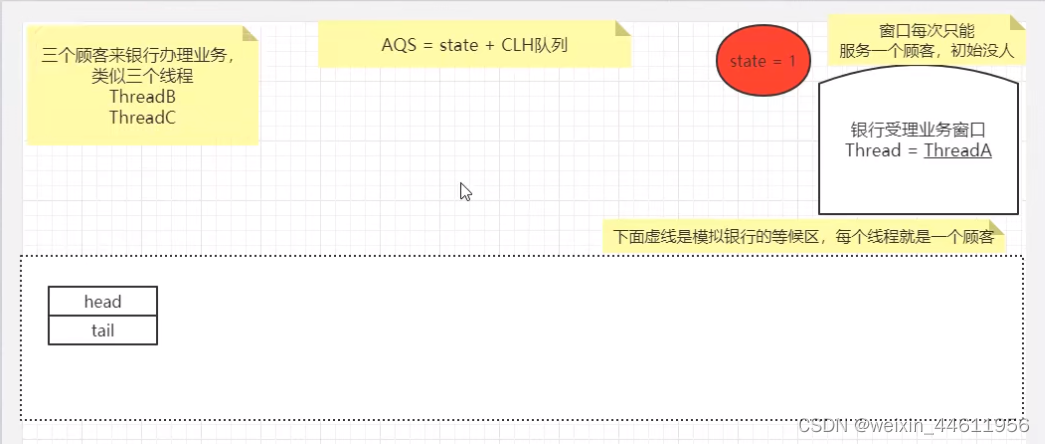
轮到线程B运行
public class ReentrantLock implements Lock, java.io.Serializable {
...
* Acquires the lock.
public void lock() {
sync.lock();//<------------------------注意,我们从这里入手,线程B的执行这
}
//非公平锁
static final class NonfairSync extends Sync {
private static final long serialVersionUID = 7316153563782823691L;
/**
* Performs lock. Try immediate barge, backing up to normal
* acquire on failure.
*/
final void lock() {//<-------------------------线程B的lock.lock()调用该方法
if (compareAndSetState(0, 1))//这是预定线程A还在工作,这里返回false
setExclusiveOwnerThread(Thread.currentThread());//
else
acquire(1);//线程B将会调用该方法,该方法在AbstractQueuedSynchronizer,
//它会调用本类的tryAcquire()方法
}
//acquire()将会间接调用该方法
protected final boolean tryAcquire(int acquires) {
return nonfairTryAcquire(acquires);//调用父类Sync的nonfairTryAcquire()
}
}
//非公平锁与公平锁的公共父类
* Base of synchronization control for this lock. Subclassed
abstract static class Sync extends AbstractQueuedSynchronizer {
//acquire()将会间接调用该方法
...
final boolean nonfairTryAcquire(int acquires) {
final Thread current = Thread.currentThread();//这里是线程B
int c = getState();//线程A还在工作,c=>1
if (c == 0) {//false
if (compareAndSetState(0, acquires)) {
setExclusiveOwnerThread(current);
return true;
}
}
else if (current == getExclusiveOwnerThread()) {//(线程B == 线程A) => false
int nextc = c + acquires;//+1
if (nextc < 0) // overflow
throw new Error("Maximum lock count exceeded");
setState(nextc);
return true;
}
return false;//最终返回false
}
...
}
...
}
public abstract class AbstractQueuedSynchronizer
extends AbstractOwnableSynchronizer
implements java.io.Serializable {
...
* Acquires in exclusive mode, ignoring interrupts. Implemented
public final void acquire(int arg) {
if (!tryAcquire(arg) &&//线程B调用非公平锁的tryAcquire(), 最终返回false,加上!,也就是true,也就是还要执行下面两行语句
acquireQueued(addWaiter(Node.EXCLUSIVE), arg))//下一节论述
selfInterrupt();
}
...
}
另外
假设线程B,C还没启动,正在工作线程A重新尝试获得锁,也就是调用lock.lock()多一次
//非公平锁与公平锁的公共父类fa
* Base of synchronization control for this lock. Subclassed
abstract static class Sync extends AbstractQueuedSynchronizer {
...
final boolean nonfairTryAcquire(int acquires) {
final Thread current = Thread.currentThread();//这里是线程A
int c = getState();//线程A还在工作,c=>1;如果线程A恰好运行到在这工作完了,c=>0,这时它又要申请锁的话
if (c == 0) {//线程A正在工作为false;如果线程A恰好工作完,c=>0,这时它又要申请锁的话,则为true
if (compareAndSetState(0, acquires)) {//线程A重新获得锁
setExclusiveOwnerThread(current);//这里相当于NonfairSync.lock()另一重设置吧!
return true;
}
}
else if (current == getExclusiveOwnerThread()) {//(线程A == 线程A) => true
int nextc = c + acquires;//1+1=>nextc=2
if (nextc < 0) // overflow
throw new Error("Maximum lock count exceeded");
setState(nextc);//state=2,说明要unlock多两次吧(现在盲猜)
return true;//返回true
}
return false;
}
...
}
public abstract class AbstractQueuedSynchronizer
extends AbstractOwnableSynchronizer
implements java.io.Serializable {
...
* Acquires in exclusive mode, ignoring interrupts. Implemented
public final void acquire(int arg) {
if (!tryAcquire(arg) &&//线程B调用非公平锁的tryAcquire(), 最终返回false,加上!,也就是true,也就是还要执行下面两行语句
acquireQueued(addWaiter(Node.EXCLUSIVE), arg))//线程B加入等待队列
selfInterrupt();//下一节论述
}
private Node addWaiter(Node mode) {
Node node = new Node(Thread.currentThread(), mode);
// Try the fast path of enq; backup to full enq on failure
Node pred = tail;
if (pred != null) {//根据上面一句注释,本语句块的意义是将新节点快速添加至队尾
node.prev = pred;
if (compareAndSetTail(pred, node)) {
pred.next = node;
return node;
}
}
enq(node);//快速添加至队尾失败,则用这方法调用(可能链表为空,才调用该方法)
return node;
}
//Inserts node into queue, initializing if necessary.
private Node enq(final Node node) {
for (;;) {
Node t = tail;
if (t == null) { // Must initialize
if (compareAndSetHead(new Node()))//插入一个哨兵节点(或称傀儡节点)
tail = head;
} else {
node.prev = t;
if (compareAndSetTail(t, node)) {//真正插入我们需要的节点,也就是包含线程B引用的节点
t.next = node;
return t;
}
}
}
}
//CAS head field. Used only by enq.
private final boolean compareAndSetHead(Node update) {
return unsafe.compareAndSwapObject(this, headOffset, null, update);
}
//CAS tail field. Used only by enq.
private final boolean compareAndSetTail(Node expect, Node update) {
return unsafe.compareAndSwapObject(this, tailOffset, expect, update);
}
...
}
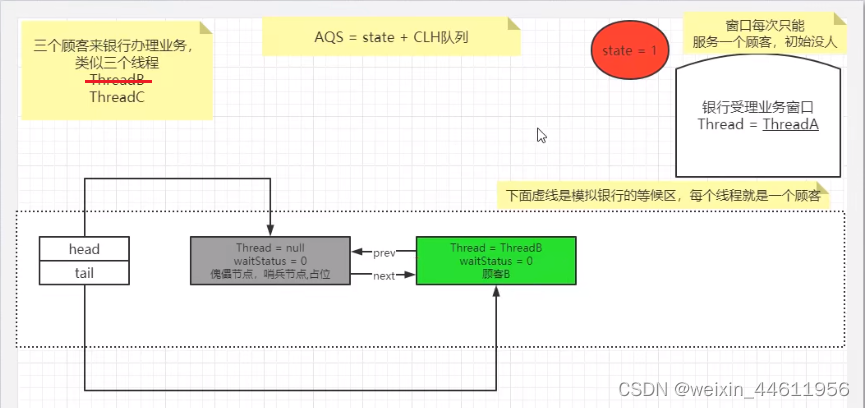
线程B加入等待队列。
线程A依然工作,线程C如线程B那样炮制加入等待队列。
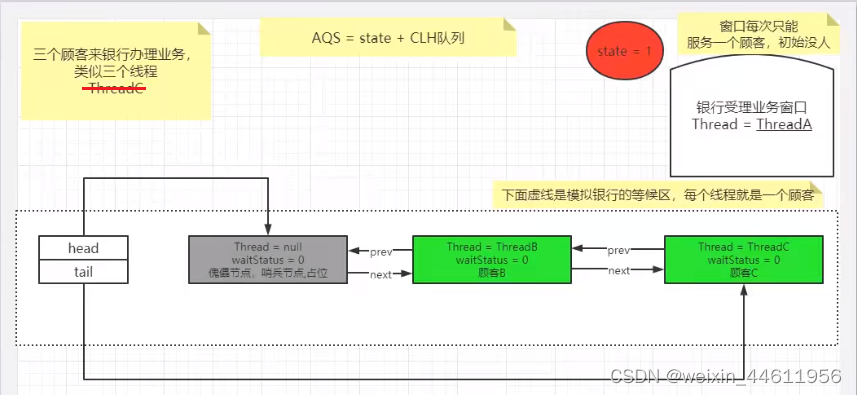
双向链表中,第一个节点为虚节点(也叫哨兵节点),其实并不存储任何信息,只是占位。真正的第一个有数据的节点,是从第二个节点开始的。
public abstract class AbstractQueuedSynchronizer
extends AbstractOwnableSynchronizer
implements java.io.Serializable {
...
* Acquires in exclusive mode, ignoring interrupts. Implemented
public final void acquire(int arg) {
if (!tryAcquire(arg) &&//线程B调用非公平锁的tryAcquire(), 最终返回false,加上!,也就是true,也就是还要执行下面两行语句
//线程B加入等待队列,acquireQueued本节论述<--------------------------
acquireQueued(addWaiter(Node.EXCLUSIVE), arg))
selfInterrupt();//
}
//Acquires in exclusive uninterruptible mode for thread already inqueue.
//Used by condition wait methods as well as acquire.
//
//return true if interrupted while waiting
final boolean acquireQueued(final Node node, int arg) {
boolean failed = true;
try {
boolean interrupted = false;
for (;;) {
final Node p = node.predecessor();//1.返回前一节点,对与线程B来说,p也就是傀儡节点
//p==head为true,tryAcquire()方法说明请转至 #21_AQS源码深度解读03
//假设线程A正在工作,现在线程B只能等待,所以tryAcquire(arg)返回false,下面的if语块不执行
//
//第二次循环,假设线程A继续正在工作,下面的if语块还是不执行
if (p == head && tryAcquire(arg)) {
setHead(node);
p.next = null; // help GC
failed = false;
return interrupted;
}
//请移步到2.处的shouldParkAfterFailedAcquire()解说。第一次返回false, 下一次(第二次)循环
//第二次循环,shouldParkAfterFailedAcquire()返回true,执行parkAndCheckInterrupt()
if (shouldParkAfterFailedAcquire(p, node) &&
//4.
parkAndCheckInterrupt())
interrupted = true;
}
} finally {
if (failed)
cancelAcquire(node);
}
}
static final class Node {
...
//1.返回前一节点
final Node predecessor() throws NullPointerException {
Node p = prev;
if (p == null)
throw new NullPointerException();
else
return p;
}
...
}
//2.
private static boolean shouldParkAfterFailedAcquire(Node pred, Node node) {
int ws = pred.waitStatus;//此时pred指向傀儡节点,它的waitStatus为0
//Node.SIGNAL为-1,跳过
//第二次调用,ws为-1,条件成立,返回true
if (ws == Node.SIGNAL)//-1
/*
* This node has already set status asking a release
* to signal it, so it can safely park.
*/
return true;
if (ws > 0) {//跳过
/*
* Predecessor was cancelled. Skip over predecessors and
* indicate retry.
*/
do {
node.prev = pred = pred.prev;
} while (pred.waitStatus > 0);
pred.next = node;
} else {
/*
* waitStatus must be 0 or PROPAGATE. Indicate that we
* need a signal, but don't park yet. Caller will need to
* retry to make sure it cannot acquire before parking.
*/
//3. 傀儡节点的WaitStatus设置为-1//下图红圈
compareAndSetWaitStatus(pred, ws, Node.SIGNAL);
}
return false;//第一次返回
}
/**
* CAS waitStatus field of a node.
*/
//3.
private static final boolean compareAndSetWaitStatus(Node node,
int expect,
int update) {
return unsafe.compareAndSwapInt(node, waitStatusOffset,
expect, update);
}
/**
* Convenience method to park and then check if interrupted
*
* @return {@code true} if interrupted
*/
//4.
private final boolean parkAndCheckInterrupt() {
//前段章节讲述的LockSupport,this指的是NonfairSync对象,
//这意味着真正阻塞线程B,同样地阻塞了线程C
LockSupport.park(this);//线程B,C在此处暂停了运行<-------------------------
return Thread.interrupted();
}
}
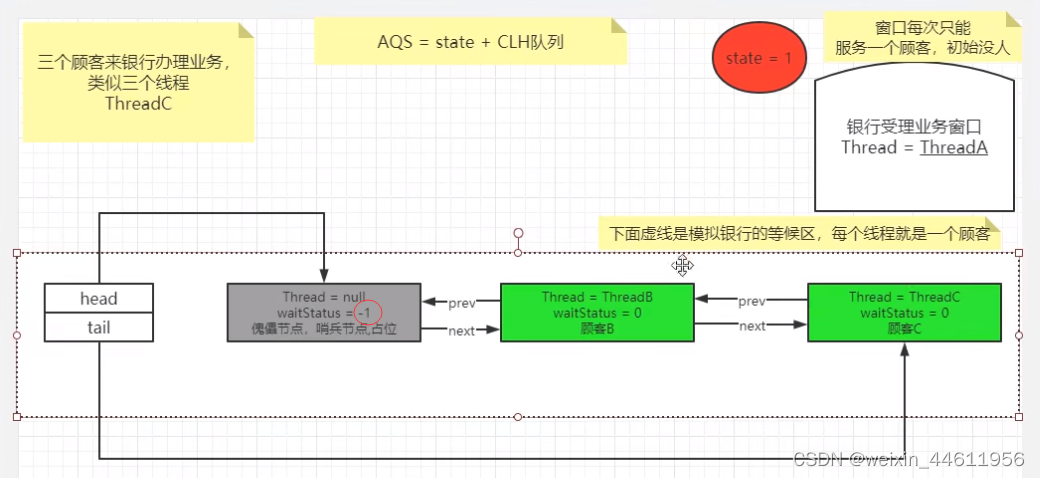
图中的傀儡节点的waitStatus由0变为-1(Node.SIGNAL)。
4.3 debug ReentrantLock.unLock()方法。假设线程A工作结束,调用unLock(),释放锁占用。
public class ReentrantLock implements Lock, java.io.Serializable {
private final Sync sync;
abstract static class Sync extends AbstractQueuedSynchronizer {
...
//2.unlock()间接调用本方法,releases传入1
protected final boolean tryRelease(int releases) {
//3.
int c = getState() - releases;//c为0
//4.
if (Thread.currentThread() != getExclusiveOwnerThread())
throw new IllegalMonitorStateException();
boolean free = false;
if (c == 0) {//c为0,条件为ture,执行if语句块
free = true;
//5.
setExclusiveOwnerThread(null);
}
//6.
setState(c);
return free;//最后返回true
}
...
}
static final class NonfairSync extends Sync {...}
public ReentrantLock() {
sync = new NonfairSync();//我们使用的非公平锁
}
//注意!注意!注意!
public void unlock() {//<----------从这开始,假设线程A工作结束,调用unLock(),释放锁占用
//1.
sync.release(1);//在AbstractQueuedSynchronizer类定义
}
...
}
public abstract class AbstractQueuedSynchronizer
extends AbstractOwnableSynchronizer
implements java.io.Serializable {
...
//1.
public final boolean release(int arg) {
//2.
if (tryRelease(arg)) {//该方法看子类NonfairSync实现,最后返回true
Node h = head;//返回傀儡节点
if (h != null && h.waitStatus != 0)//傀儡节点非空,且状态为-1,条件为true,执行if语句
//7.
unparkSuccessor(h);
return true;
}
return false;//返回true,false都无所谓了,unlock方法只是简单调用release方法,对返回结果没要求
}
/**
* The synchronization state.
*/
private volatile int state;
//3.
protected final int getState() {
return state;
}
//6.
protected final void setState(int newState) {
state = newState;
}
//7. Wakes up node's successor, if one exists.
//传入傀儡节点
private void unparkSuccessor(Node node) {
/*
* If status is negative (i.e., possibly needing signal) try
* to clear in anticipation of signalling. It is OK if this
* fails or if status is changed by waiting thread.
*/
int ws = node.waitStatus;//傀儡节点waitStatus为-1
if (ws < 0)//ws为-1,条件成立,执行if语块
compareAndSetWaitStatus(node, ws, 0);//8.将傀儡节点waitStatus由-1变为0
/*
* Thread to unpark is held in successor, which is normally
* just the next node. But if cancelled or apparently null,
* traverse backwards from tail to find the actual
* non-cancelled successor.
*/
Node s = node.next;//傀儡节点的下一节点,也就是带有线程B的节点
if (s == null || s.waitStatus > 0) {//s非空,s.waitStatus非0,条件为false,不执行if语块
s = null;
for (Node t = tail; t != null && t != node; t = t.prev)
if (t.waitStatus <= 0)
s = t;
}
if (s != null)//s非空,条件为true,不执行if语块
LockSupport.unpark(s.thread);//唤醒线程B。运行到这里,线程A的工作基本告一段落了。
}
//8.
private static final boolean compareAndSetWaitStatus(Node node,
int expect,
int update) {
return unsafe.compareAndSwapInt(node, waitStatusOffset,
expect, update);
}
}
public abstract class AbstractOwnableSynchronizer
implements java.io.Serializable {
...
protected AbstractOwnableSynchronizer() { }
private transient Thread exclusiveOwnerThread;
//5.
protected final void setExclusiveOwnerThread(Thread thread) {
exclusiveOwnerThread = thread;
}
//4.
protected final Thread getExclusiveOwnerThread() {
return exclusiveOwnerThread;
}
}
线程A结束工作,调用unlock()的tryRelease()后的状态,state由1变为0,exclusiveOwnerThread由线程A变为null。
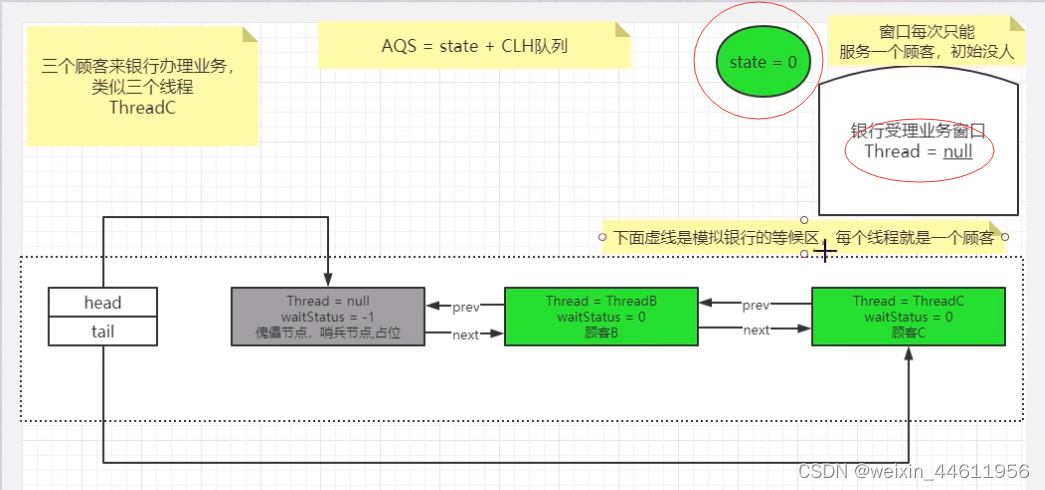
线程B被唤醒,即从原先park()的方法继续运行
public abstract class AbstractQueuedSynchronizer
extends AbstractOwnableSynchronizer
implements java.io.Serializable {
private final boolean parkAndCheckInterrupt() {
LockSupport.park(this);//线程B从阻塞到非阻塞,继续执行
return Thread.interrupted();//线程B没有被中断,返回false
}
...
//Acquires in exclusive uninterruptible mode for thread already inqueue.
//Used by condition wait methods as well as acquire.
//
//return true if interrupted while waiting
final boolean acquireQueued(final Node node, int arg) {
boolean failed = true;
try {
boolean interrupted = false;
for (;;) {
final Node p = node.predecessor();//线程B所在的节点的前一节点是傀儡节点
//傀儡节点是头节点,tryAcquire()的说明请移步至#21_AQS源码深度解读03
//tryAcquire()返回true,线程B成功上位
if (p == head && tryAcquire(arg)) {
setHead(node);//1.将附带线程B的节点的变成新的傀儡节点
p.next = null; // help GC//置空原傀儡指针与新的傀儡节点之间的前后驱指针,方便GC回收
failed = false;
return interrupted;//返回false,跳到2.acquire()
}
if (shouldParkAfterFailedAcquire(p, node) &&
//唤醒线程B继续工作,parkAndCheckInterrupt()返回false
//if语块不执行,跳到下一循环
parkAndCheckInterrupt())//<---------------------------------唤醒线程在这里继续运行
interrupted = true;
}
} finally {
if (failed)
cancelAcquire(node);
}
}
//1.
private void setHead(Node node) {
head = node;
node.thread = null;
node.prev = null;
}
//2.
* Acquires in exclusive mode, ignoring interrupts. Implemented
public final void acquire(int arg) {
if (!tryAcquire(arg) &&
//acquireQueued()返回fasle,条件为false,if语块不执行,acquire()返回
//也就是说,线程B成功获得锁,可以展开线程B自己的工作了。
acquireQueued(addWaiter(Node.EXCLUSIVE), arg))
selfInterrupt();//
}
}
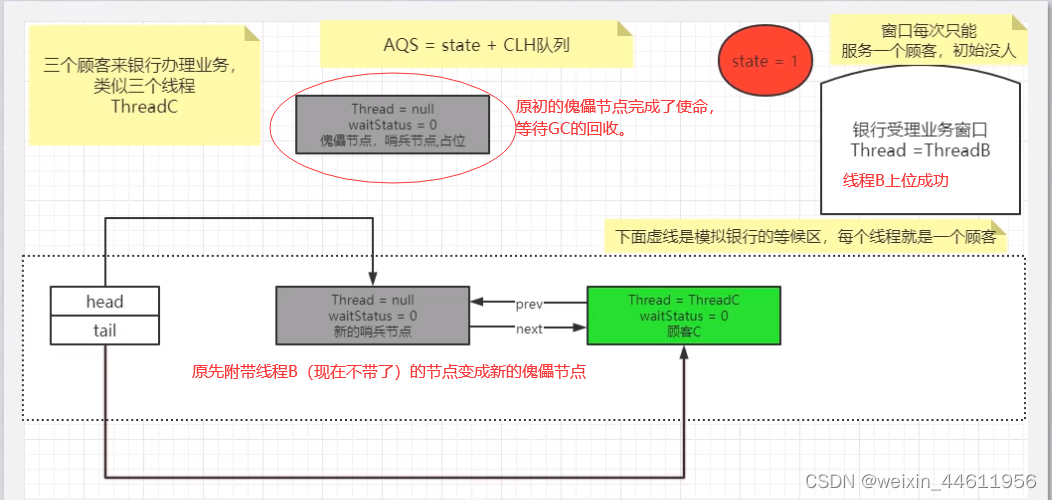






















 2591
2591











 被折叠的 条评论
为什么被折叠?
被折叠的 条评论
为什么被折叠?








